Remembering Pac & Pal, Pac-Man's Strangest Arcade Adventure
The oddest and most obscure Pac-Man sequel ever celebrates its 30th anniversary this month, but should anyone care?
This article first appeared on USgamer, a partner publication of VG247. Some content, such as this article, has been migrated to VG247 for posterity after USgamer's closure - but it has not been edited or further vetted by the VG247 team.
So here's the weird thing about the Pac-Man series: After Namco designed the legendary arcade original, thus revolutionizing the medium forever, they couldn't figure out how to make a good sequel.
Yes, this means that Ms. Pac-Man -- easily the best game in the entire series until Pac-Man DX -- didn't come from Namco. Rather, it began life as a hack called "Crazy Otto" designed by a couple of guys working for General Computer Corporation; when Namco's U.S. distributor Bally Midway saw it, they scooped it up and released it as a legitimate Pac-Man game. Different sides tell different stories, but many people believe that Ms. Pac-Man and several other Midway-produced ventures (including Pac-Man Plus, quiz game Professor Pac-Man, and weird video/pinball hybrid Baby Pac-Man) were produced and sold without Namco's consent or involvement, pushing the boundaries of Midway's Pac-Man U.S. distribution deal beyond its intended boundaries.
In any case, Namco eventually revoked Bally Midway's license and took Pac-Man back under its wing. And for good reason: Outside of Ms. Pac-Man, all those unauthorized sequels kind of stunk. They didn't do the Pac-Man brand any good and definitely muddied the U.S. arcade market when Namco imported its official sequels.
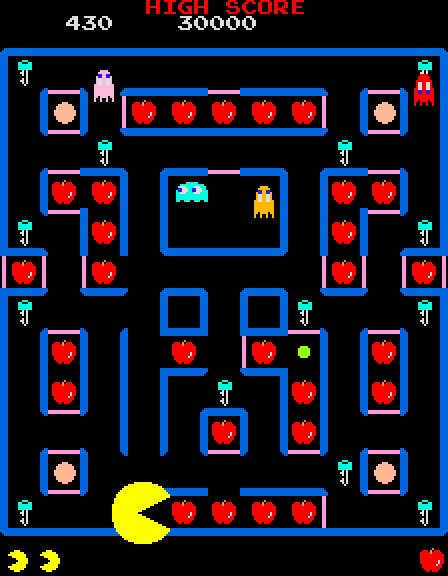
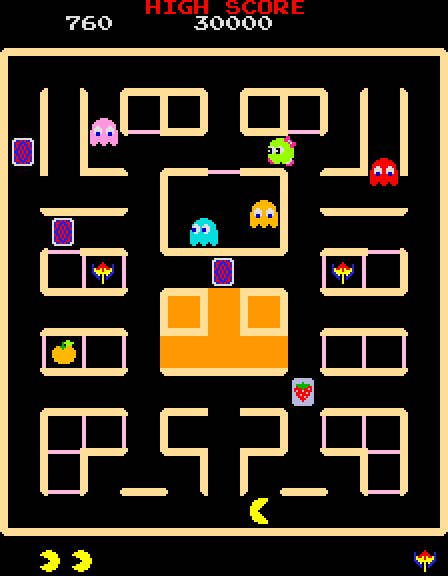
The thing is, though, Namco's official sequels weren't particularly good, either. The first "true" Pac-Man follow-up, Super Pac-Man, saw Pac-Man collecting keys to unlock maze doors, devouring fruit instead of pellets, eating two different kinds of energizers, and generally abandoning the elegant simplicity that had made the original Pac-Man so popular. Like many developers, Namco made the mistake of thinking a sequel necessitates more complex design and abandoned the principles of their formative work in favor of an overthought, overdesigned mess.
Although Super Pac-Man wasn't terribly good, that little detail didn't stop Namco from building their next sequel on its foundation. What they ended up with was Pac & Pal: One of the strangest Pac-Man games ever -- not to mention the most needlessly confusing. And the rarest, too, since it was never released in American arcades. But where Super Pac-Man's clunkiness simply made it not much fun to play, Pac & Pal is so convoluted that it becomes downright fascinating.
Much like Super Pac-Man, Pac & Pal divides its maze into open corridors and a number of locked-off chambers. This was a fairly straightforward mechanic in Super Pac-Man, which required Pac-Man to eat keys in order to unlock those barriers. That game didn't stray too far from the original game's basic premise of devouring everything in sight; the locked rooms were packed with fruit, and Pac-Man couldn't advance to the next stage until he'd eaten them all. Super Pac-Man also retained the classic energizer pellets that turned monsters blue and sent them fleeing for their lives (as well as the new super pellets that somehow made Pac-Man turn briefly huge and indestructible).
None of those fruits, energizers, or super pellets appear in Pac & Pal. Instead, its maze takes on an almost entirely barren appearance, with empty chambers and no energizers. All that dots the screen -- besides the standard "ghost house" at the center of the maze -- is a handful of playing cards and two different icons. Pac-Man flips cards by passing over top of them, revealing a fruit on the card's face and simultaneously causing that fruit to appear in a specific chamber of the maze. That chamber in turn becomes unlocked, granting Pac-Man access to collect the fruit within. It even throws out the maze's side tunnels, instead placing a large orange box at the center of the screen that obscures its contents and causes ghosts to move slowly when they enter it.
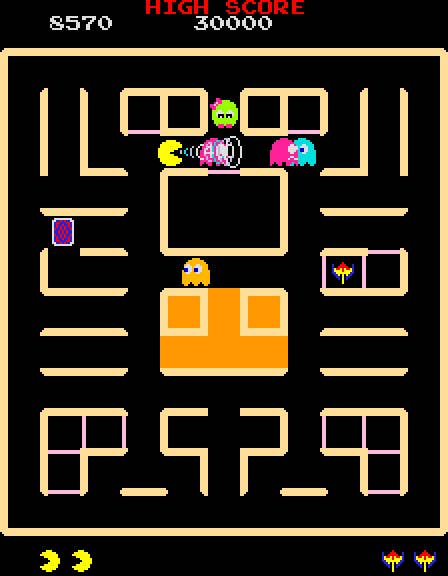
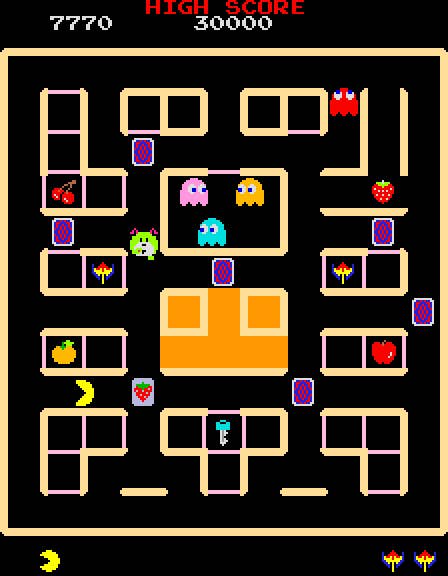
This would be an unusual enough design on its own, but it gets stranger once you factor in the "Pal" referred to in the title. In addition to Pac-Man and the four multi-colored ghosts, a sixth character roams through the maze independently of the player: A strange green ghost with a bow who looks for all the world like Lala from HAL's Adventures of Lolo series. While Pal can't hurt Pac-Man, she doesn't exactly help him, either. Instead, she wanders aimlessly until the player unlocks a room, at which point she makes a beeline for the fruit within and drags it toward the ghost house. If she manages to make it to the ghost house with fruit in tow, it becomes removed from play, robbing the player of precious points to add toward their high score tally and thus denying them arcade fame.
To add one last touch of weirdness to it all, the lack of energizers doesn't quite leave Pac-Man completely helpless. Instead, he can collect the various icons that appear in the boxes flanking the ghost house to acquire the ability to stun ghosts with projectiles. Rather than devouring his foes per usual, he can instead blast them with temporary powers to knock them silly and take them briefly out of the action. The projectile in question varies according to the power-up icon, though they're all functionally equivalent to one another. While a Galaxian flagship fires a Galaga capture beam, a trumpet blasts a burst of sound, and the Rally-X racer lays down a puff of smoke, they all stun ghosts the same.
The inclusion of these new power-ups introduces the most dramatic change in play style for the Pac-Man series to date: It expands the series' control scheme beyond a mere four-directional joystick to... a joystick and a button. While this may not seem like a particularly big deal, it changes the feel of the action to something that requires more concentration and active participation on the player's part. Much of the original Pac-Man's appeal came from its minimalist interface, which allowed players to zone out and focus on responding to actions all across the playfield without needing to worry about timing anything besides rounding corners. By placing the responsibility for taking the offense in the player's hands -- literally -- Pac & Pal demands a different set of skills. Fighting back against the ghosts is no longer as simple as turning them blue and devouring them in rapid succession. Pac-Man's projectiles have a mere two-space range, and making effective use of those powers requires getting in close to the ghosts and taking them on at short range.
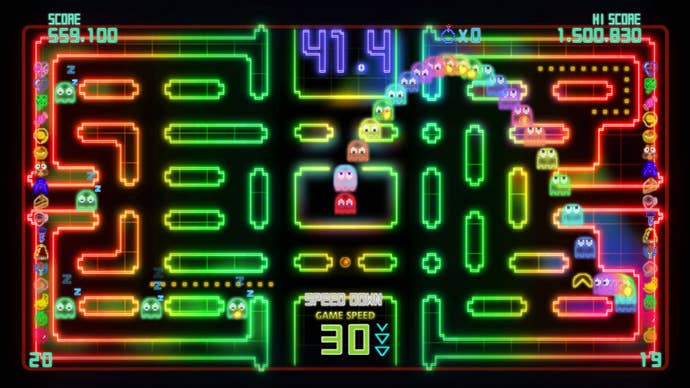
Add to this the added complication of Pal scuttling across the screen with your precious fruit (and even the power-up icons) as you worked to unlock as many barred chambers as possible, and what results was a bizarrely complicated take on Pac-Man's classic maze chase. Despite featuring fewer on-screen objects to deal with, Pac & Pal is far more challenging and stressful. It's also the first Pac-Man game to include background music during gameplay (a necessity given the lack of dots to munch noisily), but it features an almost inappropriately mellow tune in light of the high-stress and sometimes overwhelming design of the game. Interesting, the game's official art depicts Pac-Man wearing headphones, so evidently the music is meant to be what Pac-Man himself grooves to as he explores the maze.
As noted above, Pac & Pal never saw an official release in American arcades. The industry had begun to soften by 1983, and Midway had flooded U.S. arcades with their cavalcade of shoddy sequels. The Pac-Man brand had definitely seen better days, and in all honesty Pac & Pal wasn't the game turn around its fortunes. Neither, it turned out, was 1984's Pac-Land, despite being a tie-in to America's popular Pac-Man Saturday morning cartoon (not to mention a side-scrolling platformer that beat Super Mario Bros. to market by a year). Within just a few years of Pac-Man's debut, America had burned out on the character and series alike.
While Namco clearly hoped to sustain Pac-Man's tremendous legacy with an inventive follow-up, Pac & Pal hastened the series' demise. Pac & Pal was one in a string of duds and doesn't hold up very well in retrospect -- it's a real oddball of a game. Sometimes, though, weirdness is just as interesting in hindsight as true significance.
